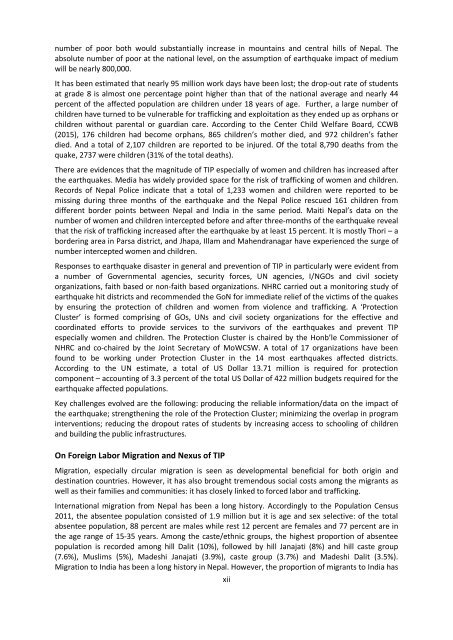TRAFFICKING IN PERSONS
397604438Trafficking_in_Persons_National_Report_2013-15
397604438Trafficking_in_Persons_National_Report_2013-15
You also want an ePaper? Increase the reach of your titles
YUMPU automatically turns print PDFs into web optimized ePapers that Google loves.
different policy initiates were undertaken by the Ministry of Labor and Employment (MoLE) aiming<br />
to protect the rights of the female migrant workers. Key migration actors in Nepal are public and<br />
private actors. Nepal has signed one bilateral agreement and two memorandums of understanding<br />
(MoUs) for temporary labor migration with governments in the Middle East: Bahrain, Qatar, and the<br />
United Arab Emirates. NHRC Nepal has entered into Memorandum of Understanding (MoU) with the<br />
National Human Rights Committee in the State of Qatar on November 16, 2015 to protect the rights<br />
of the Nepali migrant workers in Qatar.<br />
Key challenges in relation to regularization of foreign employment and prevention of TIP emerged<br />
the following: maintaining the information/data about the undocumented migrants; conducting a<br />
representative household survey that shows the linkage between migration and trafficking;<br />
discouraging the foreign employment for those who are unskilled workers; monitoring of a range of<br />
public and private actors; ensuring all migrant workers with access to effective complaints;<br />
introducing package programs to increase women cases of complaints; ensuring the right to mobility<br />
of women; conducting MoU with the major destination countries; introducing and expanding the<br />
alternative employment opportunities of the returnee WMWs.<br />
On Monitoring of Anti-Trafficking Policies, Programs and Activities<br />
Nepal has been reminded in Tire 2 over the last 5-years. Nepal has been remained in Tier 2 mainly it<br />
is because it cannot fully protect its migrant workers from slipping into forced labor situation in<br />
destination country.<br />
The Government of Nepal in collaboration with different UNs, I/NGOs has initiated and implemented<br />
different policies and programs to combat the TIP. The GoN has developed an institutional<br />
mechanism for controlling TIP. The Ministry of Women, Children and Social Welfare (MoWCSW) is<br />
the leading Ministry in this direction. It has been realized that TIP is a multi-pronged problem, and<br />
thus, it requires mobilization of a range of line agencies, constitutional and political bodies, including<br />
civil society organizations. It is also conceptualized that multi-layered of organizations role is equally<br />
important in addressing the issues of TIP. The GoN adopted NPA against Trafficking in Persons 2011-<br />
2021, taking into account the new trafficking patterns such as those associated with foreign labor<br />
migration. The NPA identifies five broad areas for interventions: prevention, protection, prosecution,<br />
capacity building, and collaboration and networking. For reinforcing the prevention and control of<br />
trafficking in women and children, a separate NPA has been implemented since 2011 and the GoN<br />
has also prepared the Implementation Action Plan of NPA.<br />
The GoN has been making national budget more gender responsive. The proportion of budget<br />
allocated for programs directly gender responsive increased from 11 percent in FY 2008/09 to nearly<br />
22 percent in the FY 2014/15. The MoWCSW has been allocating annual budget to the Eight NGOs.<br />
Government budget of Rs. 8 million to Rs. 10 million each fiscal year for providing rehab services to<br />
the trafficked survivors. Budget has also been allocated Nepali Embassy to India, Consulate General<br />
Office of Nepal in Kolkata and Nepali Embassy to Thailand in recent fiscal years. The GoN has<br />
allocated budget for the District Committee on controlling human trafficking for all 75 districts.<br />
Looking at the annual budget spent in the FY 2014/15, majority of districts in hills and mountains<br />
spent Rs. 42,000 and in Terai, Rs. 57,000. The District Committees have also the some balance<br />
amount in Emergency Rescue Fund by the end of April 2015. The average amount in the Fund comes<br />
out to be 101,980 with the range of no balance amount in Rupandehi district to Rs. 396,975 in<br />
Makwanpur district.<br />
The MoWCSW has already formed District Committees in all 75 districts in the country. Some of<br />
District Committees like Morang and Sunsari have also formulated Five-Year District Plan of Action<br />
(2015-2019). One of the advantageous of these districts Plan of Action is that they are formulated<br />
with the wide engagement of key stakeholders. The Department of Women and Children has been<br />
carrying out a number of women’s empowerment programs. A large number of women’s groups<br />
xiv


